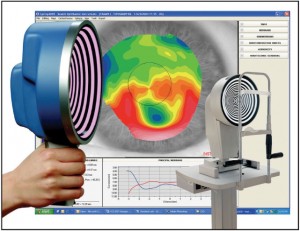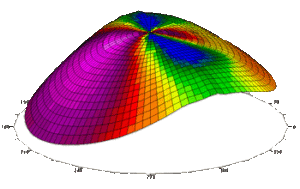Topography Keratography Diagnostic Equipment
 Introducing the latest diagnostic instrument to our Topography – Keratography practice, the Keratographer from Oculus. The Keratographer measures the surface of the cornea, much the same way that topography maps measure the elevations and contour of the earth’s surface. The Keratographer plays a critically important role in determining the quality of one’s vision. The shape of the cornea determines the visual ability of an otherwise healthy eye. A perfect eye has an evenly rounded cornea, but if the cornea is too flat, too steep or uneven, then less than perfect vision results. The greatest advantage of the Keratographer is its ability to detect conditions invisible to most conventional testing.
Introducing the latest diagnostic instrument to our Topography – Keratography practice, the Keratographer from Oculus. The Keratographer measures the surface of the cornea, much the same way that topography maps measure the elevations and contour of the earth’s surface. The Keratographer plays a critically important role in determining the quality of one’s vision. The shape of the cornea determines the visual ability of an otherwise healthy eye. A perfect eye has an evenly rounded cornea, but if the cornea is too flat, too steep or uneven, then less than perfect vision results. The greatest advantage of the Keratographer is its ability to detect conditions invisible to most conventional testing.
The Keratographer is a non-invasive medical imaging technique that maps the surface curvature of the cornea. The 3-D map produced by the Keratographer aids the doctor in the diagnosing, monitoring and treatment of various visual conditions.
 It is used in helping to diagnose and treat certain conditions of the eye, such as; keratoconus (progressive steepening of the cornea), corneal deformities, corneal scars or opacities and most importantly – the fitting of contact lenses. Another important use of the Keratographer is for pre-operative measurements for Lasik and PRK surgeries as well post-operative measurements from cataract removal.
It is used in helping to diagnose and treat certain conditions of the eye, such as; keratoconus (progressive steepening of the cornea), corneal deformities, corneal scars or opacities and most importantly – the fitting of contact lenses. Another important use of the Keratographer is for pre-operative measurements for Lasik and PRK surgeries as well post-operative measurements from cataract removal.
